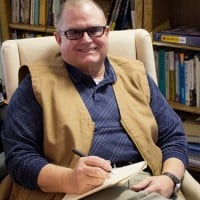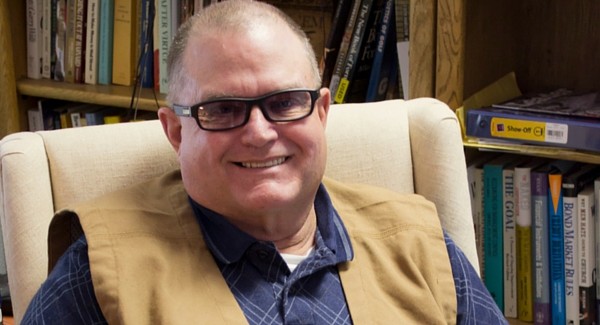“You are only as good as the things you love.”
Those are words to live by according to Dr. George Smith, Associate Professor of Accountancy at Newman and a man with many interesting hobbies.
At the beginning of Smith’s 20-year career at Newman, he made a point of being an active member of the Newman community, and has come very close with many students and colleagues. More recently, Smith decided to sit in on courses outside the Business division. These courses included history, theology – and the class that really got his attention: Creative Writing with Prof. Bryan Dietrich. In this class, Smith became a poet.
Each year Newman invites students and faculty to submit short stories, poetry and creative nonfiction manuscripts to the Coelacanth literary journal. Coelacanth (pronounced see-la-canth) is a professionally produced journal that offers two annual literary prizes as judged by nationally known writers. After much debate, Dietrich was able

to coax Smith into submitting a few poems. Soon after, Smith received an invitation from the English Department to the first readings of Coelacanth – and was astonished to find that he was the winner of the Sister Madeline Kisner Prize in Poetry.
As Smith continues his poetry career, he has been inspired by one particular poet: Wallace Stevens, an underwriter, attorney, Hartford Insurance Company executive and, in Smith’s opinion, the greatest American modernist poet of the 20th century. Stevens was a deep thinker and wrote about everything, except business. This has motivated Smith to work on a series of poems about the business world, which he hopes to eventually compile into a book-length manuscript.
Long before he discovered his love for poetry, Smith was a well-known face on campus. Daily walks around the indoor track of O’Shaughnessy Hall allowed him to observe basketball practice. He soon became intrigued and was impressed with how the team prepared for each game. Before long, Head Men’s Basketball Coach Mark Potter invited Smith to the practices. Over the years, he has become an honorary coach and mentor for the team, and he remains active today keeping the game shot chart.
In the past Smith has also served as mentor to the Women’s Golf Team. This was a natural fit for Smith; even at an early age he had a passion for the game. His passion and appreciation not only existed on the course, but also on pen and paper. His contributions to golf literature and poetry have been published through an online forum, GolfWRX.com.
For George Smith, his experience at Newman has flowered into much more than teaching and developing accounting classes. It has allowed him to connect to a community and become a mentor for student-athletes. It has also permitted him to explore new knowledge, resulting in the discovery of his true passion – connecting the dots between the world of business and poetry.
Come Find Me
Come find me on the old dirt road
That wound over the rise
And beside the old windmill
That I dug and built to water my cattle
Before I sold the land
To that banker woman who turned
The ranch into trailer parks
Where the people who built the highway stayed
And to milo. It was a tall tepee,
The windmill was, made of pine logs and wire
and metal wings and sweat. You could see it for miles
It was the tallest thing on the prairie then
Between Friona and Happy.
Now there’s an elevator where the highway turns north south
Where the grain trucks lineup to disgorge
When the milo has been cut and loaded.
They don’t need my windmill now I guess
Now that there are no cattle
Only fields of milo, trucked to the elevator
And then to the feedlots to feed the cattle
Who never gave a tinker’s damn. Who don’t know
There was a tall windmill on the small hill
On the old dirt road that ran
Across the prairie between Friona and Happy.
Editor’s note: This article and Dr. Smith’s poem appeared in the Spring 2015 issue of Inside Newman Magazine.

